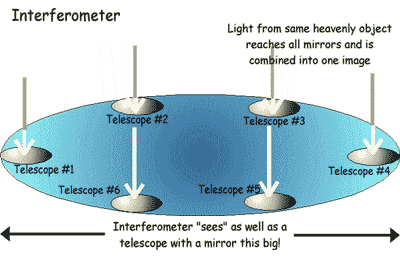
Even Bigger

| The two giant Keck Telescopes sit high atop an extinct volcano (called Mauna Kea) on the "Big Island" of Hawaii. Telescopes (except for radio telescopes) do better if they are as high up as possible. That way, they have less air to look through to see the stars.
Each of the telescopes uses a curved mirror to gather light from the night sky. Each mirror is 10 meters (about 33 feet) across. That's about the width of a tennis court! The mirrors are big because the bigger (and more perfect) the mirror, the better the image the telescope makes. Even better, the two mirrors can be used together to look at the same object in the sky. The images must be combined very precisely. But that combined image is MUCH better than one telescope alone could get. The image is almost as good as if it were made with a telescope mirror as wide as the whole distance between the far edges of the two telescopes' mirrors. In the case of the Keck Telescopes, this distance is 85 meters (280 feet). That's a mirror almost the length of a football field across! Can you imagine the domed roof you'd have to build over that? This technique of combining the images from more than one telescope is called interferometry (in-ter-fear-AH-muh-tree).
 NASA is hoping to make even better use of this technology by adding four more smaller telescopes on top of Mauna Kea. These four proposed "outrigger" telescopes would each have mirrors about two meters across. They would be placed in very precise positions. Then their images would be very precisely combined with the images from the big Keck Telescopes. The "aperture" is the light-gathering part of the telescope, like the mirror. "Synthesis" means putting together. So this new telescope would be a giant "aperture synthesis telescope." It would be known as the Keck Interferometer. What would this giant interferometer do? It would look for planets around other stars. For this job, we need extremely good eyes. Of course, our own eyes are far too weak. The technology of interferometry enables astronomers to use the method of astrometry to look for planets. Astrometry is the study of the tiny "wobbles" in a star's position that might indicate a large planet in orbit. Even our biggest and best ground-based telescopes can't see this motion all by themselves. Also, read all about the amazing StarLight space telescopes and how they will test the technology of interferometry in space. And read more about why orbiting planets would cause a star to wobble in the first place.
|
 |
 |
 |
 |
 |
 |
|
| |||||